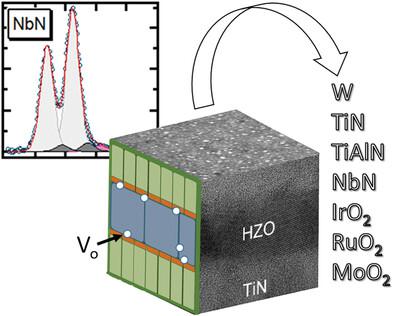当前位置:
X-MOL 学术
›
Adv. Funct. Mater.
›
论文详情
Our official English website, www.x-mol.net, welcomes your
feedback! (Note: you will need to create a separate account there.)
The Electrode-Ferroelectric Interface as the Primary Constraint on Endurance and Retention in HZO-Based Ferroelectric Capacitors
Advanced Functional Materials ( IF 18.5 ) Pub Date : 2023-06-25 , DOI: 10.1002/adfm.202303261 Ruben Alcala 1, 2 , Monica Materano 1 , Patrick D. Lomenzo 1 , Pramoda Vishnumurthy 1 , Wassim Hamouda 3, 4 , Catherine Dubourdieu 3, 5 , Alfred Kersch 6 , Nicolas Barrett 4 , Thomas Mikolajick 1, 2 , Uwe Schroeder 1
Advanced Functional Materials ( IF 18.5 ) Pub Date : 2023-06-25 , DOI: 10.1002/adfm.202303261 Ruben Alcala 1, 2 , Monica Materano 1 , Patrick D. Lomenzo 1 , Pramoda Vishnumurthy 1 , Wassim Hamouda 3, 4 , Catherine Dubourdieu 3, 5 , Alfred Kersch 6 , Nicolas Barrett 4 , Thomas Mikolajick 1, 2 , Uwe Schroeder 1
Affiliation

|
Ferroelectric hafnium-zirconium oxide is one of the most relevant CMOS-compatible materials for next-generation, non-volatile memory devices. Nevertheless, performance reliability remains an issue. With TiN electrodes (the most reported electrode material), Hf-Zr-based ferroelectric capacitors struggle to provide reliable retention due to electrode-ferroelectric interface interactions. Although Hf-Zr-based ferroelectric capacitors are fabricated with other electrodes, the focus is predominantly directed toward obtaining a large ferroelectric response. The impact of the electrodes on data retention for these ferroelectrics remains underreported and greater insight is needed to improve device reliability. Here, a comprehensive set of electrodes are evaluated with emphasis on the core ferroelectric memory reliability metrics of endurance, retention, and imprint. Metal-ferroelectric-metal capacitors comprised of a Hf0.5Zr0.5O2 layer deposited between different combinations of nitride (TiN, TiAlN, and NbN), pure metal (W), and oxide (MoO2, RuO2, and IrO2) top and bottom electrodes are fabricated for the investigation. From the electrical, physical, and structural analysis, the low reactivity of the electrode with the ferroelectric is found to be key for improved reliability of the ferroelectric capacitor. This understanding of interface properties provides necessary insight for the broad implementation of Hf-Zr-based ferroelectrics in memory technology and, overall, boosts the development of next-generation memories.
中文翻译:

电极-铁电界面作为 HZO 基铁电电容器耐久性和保持力的主要约束
铁电铪锆氧化物是下一代非易失性存储器件最相关的 CMOS 兼容材料之一。尽管如此,性能可靠性仍然是一个问题。对于 TiN 电极(报道最多的电极材料),Hf-Zr 基铁电电容器由于电极-铁电界面相互作用而难以提供可靠的保持力。尽管 Hf-Zr 基铁电电容器是用其他电极制造的,但焦点主要集中在获得大的铁电响应。电极对这些铁电体数据保留的影响仍未得到充分报道,需要更深入的了解来提高设备可靠性。在这里,对一组全面的电极进行评估,重点是耐久性、保留率和印记等核心铁电存储器可靠性指标。金属-铁电-金属电容器由沉积在氮化物(TiN、TiAlN 和 NbN)、纯金属 (W) 和氧化物(MoO 2、RuO 2和 IrO 2)的不同组合之间的 Hf 0.5 Zr 0.5 O 2层组成顶部和底部电极是为研究而制造的。从电学、物理和结构分析来看,电极与铁电体的低反应性被发现是提高铁电电容器可靠性的关键。对界面特性的了解为 Hf-Zr 基铁电体在存储器技术中的广泛应用提供了必要的见解,总体而言,促进了下一代存储器的开发。
更新日期:2023-06-25
中文翻译:

电极-铁电界面作为 HZO 基铁电电容器耐久性和保持力的主要约束
铁电铪锆氧化物是下一代非易失性存储器件最相关的 CMOS 兼容材料之一。尽管如此,性能可靠性仍然是一个问题。对于 TiN 电极(报道最多的电极材料),Hf-Zr 基铁电电容器由于电极-铁电界面相互作用而难以提供可靠的保持力。尽管 Hf-Zr 基铁电电容器是用其他电极制造的,但焦点主要集中在获得大的铁电响应。电极对这些铁电体数据保留的影响仍未得到充分报道,需要更深入的了解来提高设备可靠性。在这里,对一组全面的电极进行评估,重点是耐久性、保留率和印记等核心铁电存储器可靠性指标。金属-铁电-金属电容器由沉积在氮化物(TiN、TiAlN 和 NbN)、纯金属 (W) 和氧化物(MoO 2、RuO 2和 IrO 2)的不同组合之间的 Hf 0.5 Zr 0.5 O 2层组成顶部和底部电极是为研究而制造的。从电学、物理和结构分析来看,电极与铁电体的低反应性被发现是提高铁电电容器可靠性的关键。对界面特性的了解为 Hf-Zr 基铁电体在存储器技术中的广泛应用提供了必要的见解,总体而言,促进了下一代存储器的开发。

































 京公网安备 11010802027423号
京公网安备 11010802027423号